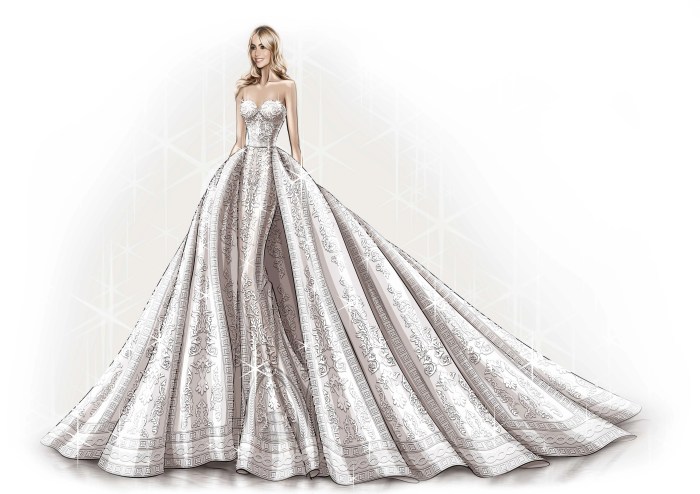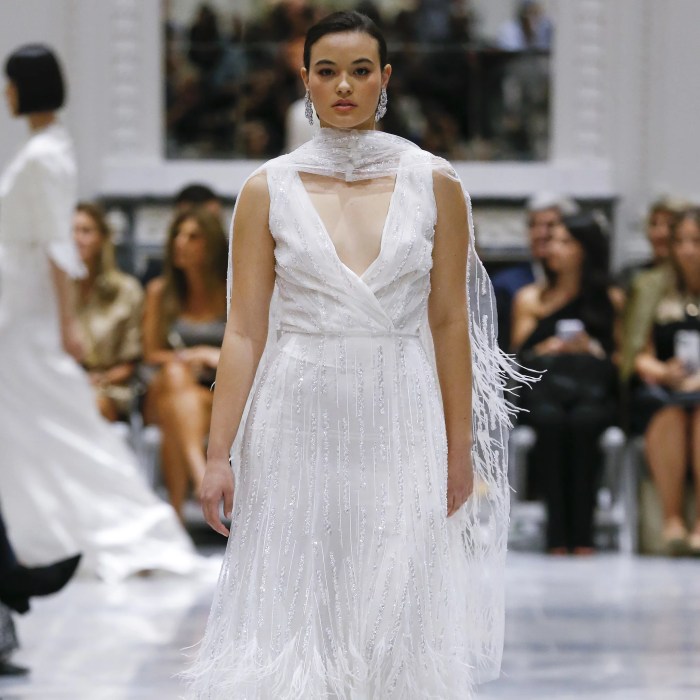Designer Wedding Dresses: A Guide to Finding Your Perfect Gown
Designer dresses for wedding – Choosing a designer wedding dress is a significant step in planning your special day. This guide explores various aspects of designer gowns, from understanding different styles and brands to selecting fabrics, embellishments, and finding the perfect fit.
Types of Designer Wedding Dresses
Designer wedding dresses come in a variety of styles, each flattering different body types and suitable for various wedding settings. Understanding these styles is crucial for finding the perfect gown.
| Style | Characteristics | Suitable Body Types | Suitable Occasions |
|---|---|---|---|
| A-line | Fitted at the bodice and gradually flares out from the waist, creating a flattering silhouette. | Most body types | Most wedding venues |
| Ballgown | Full skirt, often with a fitted bodice, creating a princess-like look. | Most body types, especially those with smaller waists | Formal weddings, ballrooms |
| Mermaid | Fitted from the bodice to the knees or mid-thigh, then flares out dramatically. | Hourglass or athletic figures | Formal weddings, elegant venues |
| Sheath | Simple, close-fitting silhouette that skims the body. | Slender body types | Modern or minimalist weddings |
| Empire Waist | Fitted bodice just below the bust, flowing loosely to the floor. | Most body types, particularly those who want to emphasize the upper body | Casual or romantic weddings |
For example, an A-line dress in silk charmeuse with delicate lace appliqués offers a classic and elegant look, suitable for a variety of venues. A ballgown in luxurious satin with intricate beading would be perfect for a grand ballroom wedding. A mermaid gown in embroidered tulle would be stunning for a formal evening event.
Popular Designer Brands
Several renowned designers specialize in creating exquisite wedding gowns. Each brand offers a unique aesthetic and price range, catering to diverse preferences and budgets.
- Vera Wang: Known for its dramatic silhouettes and luxurious fabrics, Vera Wang dresses often feature intricate detailing and are generally high-end.
- Monique Lhuillier: Celebrated for its romantic and feminine designs, Monique Lhuillier gowns often incorporate delicate lace, soft tulle, and flowing silhouettes, typically in a higher price range.
- Oscar de la Renta: Oscar de la Renta dresses are known for their classic elegance and sophisticated detailing, featuring high-quality fabrics and intricate embellishments, placing them in the luxury price segment.
- Pronovias: Pronovias offers a wider range of styles and price points, providing options for various tastes and budgets.
Vera Wang prioritizes bold silhouettes and dramatic designs, while Monique Lhuillier focuses on romantic and ethereal aesthetics. Oscar de la Renta emphasizes classic elegance and timeless sophistication. These designers represent distinct design philosophies, showcasing different approaches to bridal fashion.
Dress Fabrics and Embellishments

Source: vogue.com
The choice of fabric and embellishments significantly impacts the overall look and feel of a designer wedding dress. Understanding these elements is key to selecting a gown that reflects personal style.
- Silk: Luxurious, smooth, and drapes beautifully. Requires professional cleaning.
- Lace: Delicate, intricate, and adds a romantic touch. Can be delicate and require careful handling.
- Tulle: Lightweight, sheer, and often used for creating volume and texture. Relatively easy to care for.
- Satin: Smooth, shiny, and drapes elegantly. Prone to wrinkles and requires careful handling.
| Embellishment | Description | Effect | Examples |
|---|---|---|---|
| Beading | Small beads sewn onto the fabric. | Adds sparkle and texture. | Crystal beading, pearl beading |
| Embroidery | Threads are stitched onto the fabric to create patterns or designs. | Adds detail and artistry. | Floral embroidery, geometric embroidery |
| Appliqués | Decorative pieces attached to the fabric. | Adds dimension and visual interest. | Lace appliqués, floral appliqués |
| Sequins | Small, shiny discs sewn onto the fabric. | Adds sparkle and glamour. | Various colors and sizes |
Finding and Purchasing Designer Dresses, Designer dresses for wedding

Source: popsugar-assets.com
Acquiring a designer wedding dress involves careful planning and consideration. This section provides a structured approach to the process.
- Research designers and their styles.
- Book appointments at bridal salons.
- Set a realistic budget.
- Try on dresses and gather feedback.
- Select the dress and order it.
- Schedule alterations for a perfect fit.
When trying on dresses, ask questions such as: Does the dress flatter my body type? Is the fabric comfortable? Does the style suit my wedding venue and theme? Does the dress fit within my budget?
Alterations are crucial for ensuring the perfect fit. A skilled seamstress can adjust the length, bodice, and other aspects to create a flawless look.
Styling Designer Wedding Dresses
Styling a designer wedding dress involves selecting accessories, hair, and makeup that complement the gown’s style and the overall wedding theme.
Classic Styling: A timeless A-line gown paired with a cathedral-length veil, elegant updo, and subtle makeup.
Modern Styling: A sleek sheath dress with minimal accessories, a loose, textured hairstyle, and a bold lip.
Bohemian Styling: A flowing empire waist gown with floral crown, loose waves, and natural makeup.
Accessories should be chosen based on the wedding venue. A simple headband might suit a beach wedding, while statement jewelry might be appropriate for a ballroom.
The selection of a designer dress for a wedding is a significant decision, impacting the overall aesthetic of the event. Just as careful consideration is given to the dress’s design and fit, so too should attention be paid to the wedding’s reception space; for inspiration, one might consult resources like einrichten wohnzimmer beispiele for ideas on creating a cohesive and elegant atmosphere.
Ultimately, both the dress and the reception space contribute to the memorable experience of the wedding day.
The wedding theme should guide accessory choices. A rustic theme might call for natural flowers, while a glamorous theme might require sparkling jewelry.
Illustrative Examples of Designer Wedding Dresses
These descriptions showcase the artistry and detail that go into creating a designer wedding dress.
Dress 1: A classic A-line gown crafted from ivory silk charmeuse, delicately embroidered with intricate lace patterns that cascade down the skirt. The bodice features a sweetheart neckline, subtly accentuating the décolletage. The flowing silhouette creates a graceful and elegant look, perfect for a traditional church wedding. The dress is further enhanced with delicate pearl beading along the waistline, adding a touch of understated glamour. The train is of moderate length, adding to the overall elegance without being overwhelming. The dress’s simplicity is elevated by the high-quality fabric and meticulous craftsmanship, creating a timeless piece that will be cherished for years to come.
Dress 2: A modern minimalist wedding dress in crisp white crepe, featuring clean lines and a sleek silhouette. The dress boasts a high neckline and long sleeves, creating a sophisticated and understated look. The lack of embellishments allows the quality of the fabric and the simple, elegant design to take center stage. The dress is perfect for a modern, minimalist wedding in a contemporary art gallery or a stylish city loft. The simplicity of the dress allows for a focus on the bride’s natural beauty and allows for bolder accessories to be incorporated without overwhelming the look. The crepe fabric drapes beautifully, enhancing the dress’s overall sophistication and elegance.
Dress 3: A romantic ballgown crafted from layers of soft tulle, creating a full, voluminous skirt that evokes a fairytale aesthetic. The bodice is fitted and features delicate lace appliqués that extend down the sleeves. The gown is accented with scattered crystal beading, adding a touch of sparkle and shimmer. The overall effect is ethereal and romantic, perfect for a whimsical garden wedding or a grand ballroom celebration. The tulle’s airy texture and the delicate lace appliqués create a sense of lightness and grace, while the crystal beading adds a touch of sophisticated glamour. The dress is a testament to the artistry of design, perfectly balancing romance and elegance.
Frequently Asked Questions: Designer Dresses For Wedding
How far in advance should I start looking for a designer wedding dress?
Ideally, begin your search 9-12 months before your wedding to allow ample time for fittings, alterations, and potential delays.
What is the average price range for designer wedding dresses?
Prices vary greatly depending on the designer, fabric, and embellishments. Expect a wide range, from several thousand to tens of thousands of dollars.
Can I alter a designer wedding dress significantly?
Most alterations are possible, but major structural changes might be limited depending on the dress’s design and construction. Consult with a professional seamstress.
How do I care for my designer wedding dress after the wedding?
Professional cleaning and preservation are highly recommended to protect your investment. Follow the care instructions provided by the designer.
